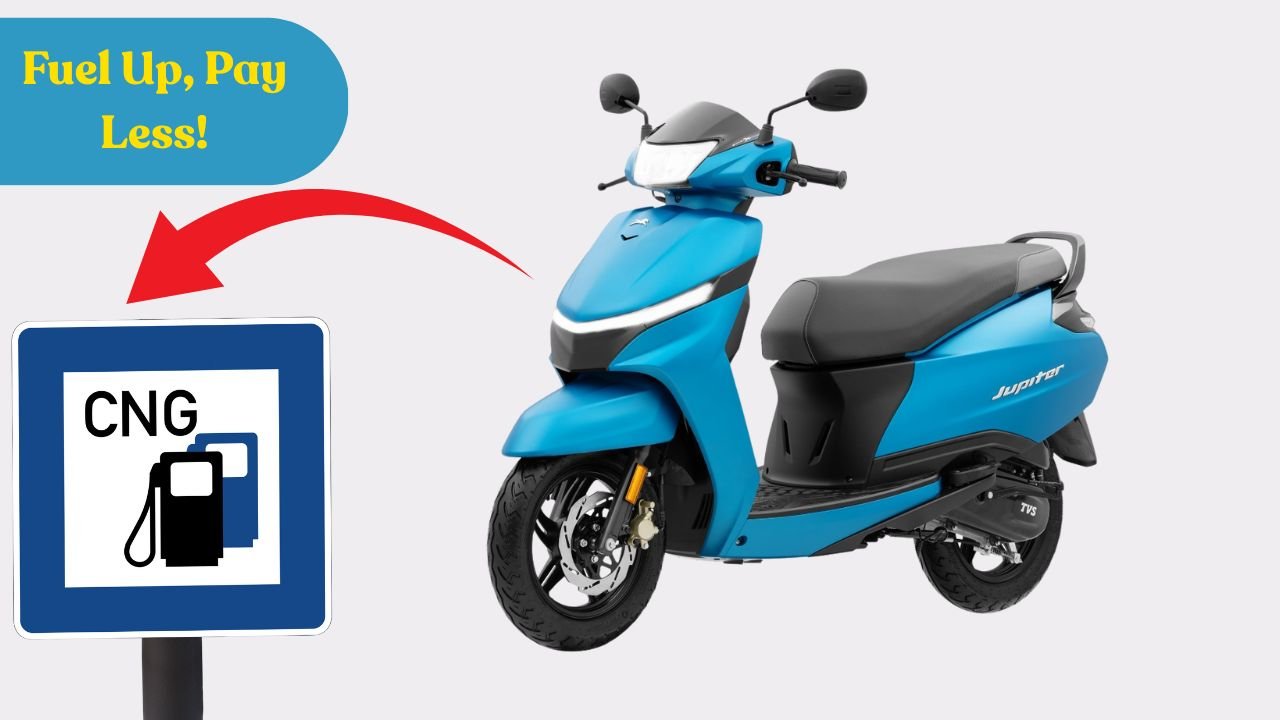TVS Motor Company is making waves with its new TVS Jupiter CNG 2025. This scooter is special because it runs on both petrol and CNG (compressed natural gas). It is designed for city riders and will be available by early 2026. This scooter promises a cleaner ride and can save money on fuel.
With fuel prices rising and air pollution increasing, TVS aims to offer a practical solution. The Jupiter CNG can help city commuters save money and reduce pollution at the same time.
Dual-Fuel Technology: What Makes It Special
The TVS Jupiter CNG 2025 uses dual-fuel technology. This means you can switch between petrol and CNG anytime. It is the first scooter in the world to have this feature. The scooter has a 1.4 kg CNG tank and a 2-litre petrol tank. Riders can choose the fuel based on availability and cost.
CNG is cheaper than petrol, and TVS claims the scooter can run about 84 km per kg of CNG. This makes it a smart choice for daily commuters who want to save on fuel.
TVS Jupiter CNG 2025 Specifications
The Jupiter CNG keeps the style and design of the popular Jupiter 125 but adds the CNG system. Here are the key specs:
| Feature | Specification |
|---|---|
| Engine | 124.8cc, single-cylinder, 7.2 PS, 9.4 Nm torque |
| Transmission | CVT for smooth ride |
| Fuel Efficiency | 84 km per kg CNG, total range 226 km (CNG + petrol) |
| Top Speed | 80 km/h |
| Design | Stylish with small changes for CNG tank |
These features make it both eco-friendly and practical for city roads.
History of Dual-Fuel Vehicles in India
India loves two-wheelers. There are over 100 million on the roads. Switching to alternative fuels has been slow, but now pollution is a big concern. The government is promoting cleaner vehicles.
Dual-fuel scooters like the TVS Jupiter CNG are a step forward. CNG vehicles pollute less than petrol ones. This aligns with India’s push for cleaner transport, like the FAME scheme for electric and hybrid vehicles.
What Experts Say
Rajiv Agarwal, an automotive analyst, says, “Dual-fuel technology in scooters is a game-changer. CNG has been popular in buses and taxis. Now, individual riders can also save money and help the environment.”
Ravi Kumar, an environmental consultant, adds, “CNG scooters are a positive step. Moving away from petrol is important, and TVS Jupiter CNG can help cities adopt clean energy.”
CNG Use in India
India is pushing CNG as a cleaner fuel. The government is building more CNG stations and offering subsidies. There are over 3,000 CNG stations in India now, and more are coming.
However, rural areas still have fewer stations. This may slow down adoption outside big cities.
TVS Jupiter CNG Pricing
The TVS Jupiter CNG 2025 is expected to cost between ₹95,000 and ₹1,00,000 (ex-showroom). It may be slightly higher than petrol scooters, but it saves money in the long run. Fuel savings and environmental benefits make it worth considering.
TVS is also offering discounts, making it more attractive for city commuters.
Comparing TVS Jupiter CNG with Other Scooters
Here’s a simple comparison:
| Type | Example | Pros | Cons |
|---|---|---|---|
| Electric | Ather 450X, Bajaj Chetak | Zero pollution, low running cost | Limited range, charging stations rare |
| Petrol | Honda Activa, Bajaj Pulsar | Easy to refill, reliable | Expensive fuel, more pollution |
| Dual-Fuel (TVS Jupiter CNG) | Jupiter CNG 2025 | Flexible fuel, cheaper running, eco-friendly | Higher initial cost, limited CNG stations |
The Jupiter CNG is a good middle option. It combines low cost, cleaner fuel, and convenience.
Challenges for TVS Jupiter CNG
There are some challenges. First, not all areas have CNG stations yet. Rural buyers may find it hard to use CNG regularly.
Second, the scooter costs more upfront than petrol models. Long-term savings are good, but price-sensitive buyers might hesitate.
Conclusion
The TVS Jupiter CNG 2025 is a game-changer for city riders in India. It offers the best of both worlds with petrol and CNG, helping you save money and reduce pollution. With its stylish design, decent speed, and good fuel efficiency, it is practical for daily commutes. While challenges like limited CNG stations and higher upfront cost exist, the long-term benefits make it a smart and eco-friendly choice for modern urban riders.



